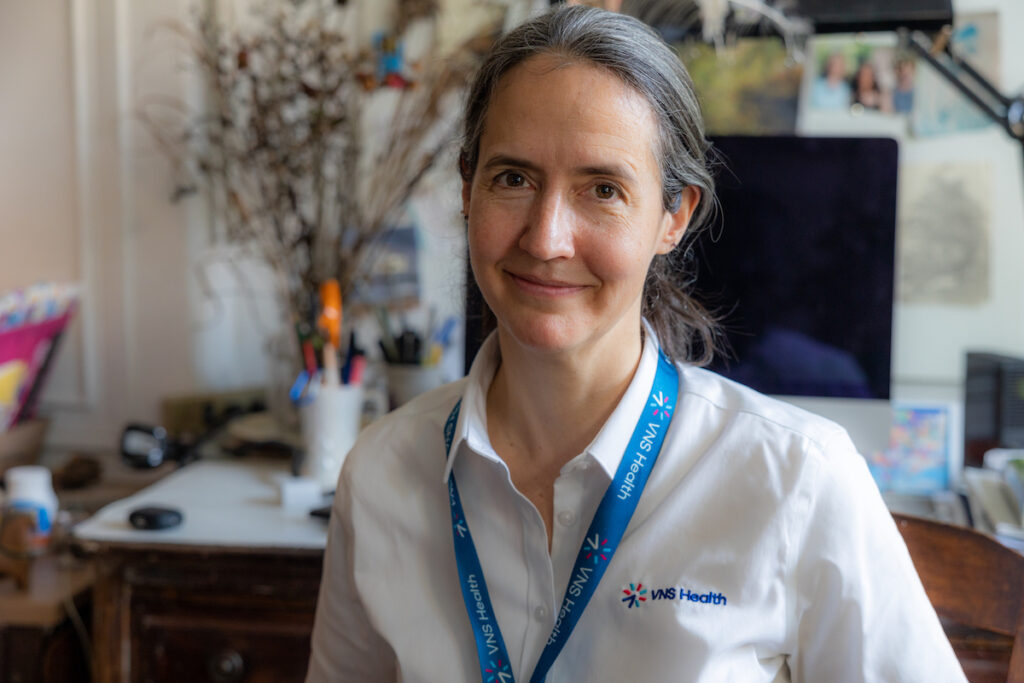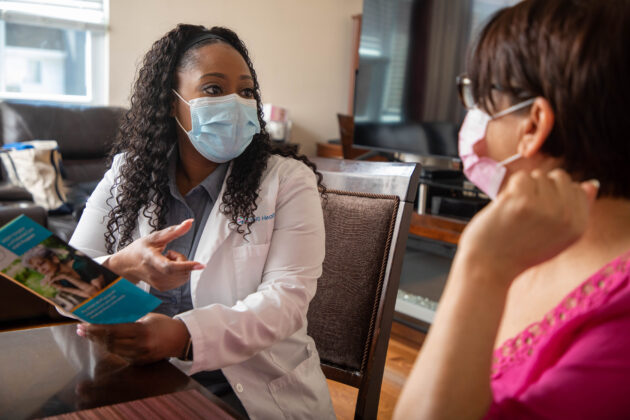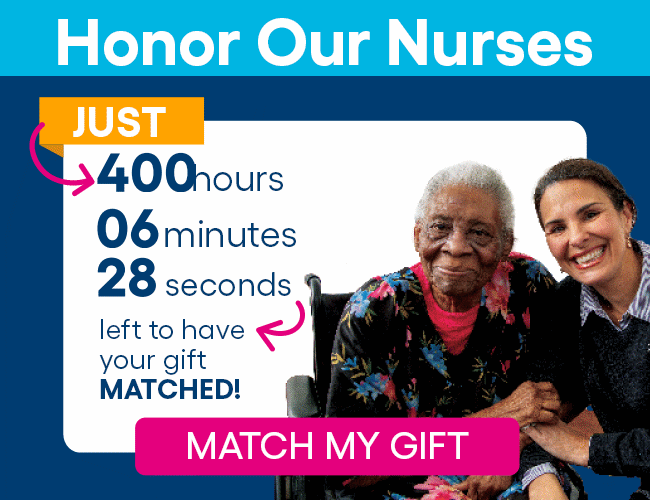
Improved quality of life, better pain management, increased caregiver support, cost savings — the benefits of hospice care are numerous. The sooner an eligible person enters hospice, the longer they get to experience these benefits.
Unfortunately, most patients enter hospice in their last days of life: they go to the hospital for emergency care and experience a crisis that prevents discharge. They and their families may learn that their prognosis is only a few days, so they choose to enter hospice care while in the hospital. However, many patients who are referred to hospice later in their illness trajectory could have actually started hospice several months earlier. Additionally, late referral, which may mean entering hospice at the general inpatient level of care, is costly for everyone involved, from patients and their loved ones to hospitals and Medicare.
When your patient has a terminal illness, referring them to hospice early provides them the opportunity to take advantage of its benefits for a longer time and have a better quality of life during their last few months.
If you have concerns about referring your patient to hospice early, here is some advice from experts at VNS Health.
Know When to Refer to Hospice
People are eligible for hospice care if they have a terminal illness and their prognosis is 6 months or less, providing their disease runs its typical course. Often, however, patients at that 6-month mark don’t seem like they’re ready for or need hospice. There are a number of indicators that can help you determine the right time to discuss hospice care with your patients who are nearing the end of life.
The Palliative Performance Scale
One of the main indicators of hospice readiness is a patient’s level on the Palliative Performance Scale (PPS) — a tool that allows you to assess a person’s functioning in terms of five areas: ambulation, activity and evidence of disease, ability to perform self-care, intake, and consciousness level.
The PPS is broken down by levels in 10% increments, with higher levels indicating higher functioning. For example, a level of 100% means that someone has full functioning in all five areas.
Hospice care is appropriate once a patient has a level of 70% or less, which may present as a higher level of functioning than is often associated with hospice eligibility. However, nearly 50% of patients receive hospice care for 3 weeks or less. By the time they enter hospice, they are often bedbound and unable to do any activities, and their food intake is reduced.
| PPS Level | Ambulation | Activity and Evidence of Disease |
Self-Care | Intake | Conscious Level |
|---|---|---|---|---|---|
STABLE |
|||||
| 100% | Full | Normal activity and work / No evidence of disease | Full | Normal | Full |
| 90% | Full | Normal activity and work / Some evidence of disease | Full | Normal | Full |
| 80% | Full | Normal activity with effort / Some evidence of disease | Full | Normal or reduced | Full |
HOSPICE APPROPRIATE |
|||||
| 70% | Reduced | Unable to do normal job or work / Significant disease | Full | Normal or reduced | Full |
| 60% | Reduced | Unable to do hobby or housework / Significant disease | Occasional assistance necessary | Normal or reduced | Full confusion |
| 50% | Mainly sit/lie | Unable to do any work / Extensive disease | Considerable assistance required | Normal or reduced | Full confusion |
| 40% | Mainly in bed | Unable to do most activity / Extensive disease | Mainly assistance | Normal or reduced | Full or drowsy +/- confusion |
| 30% | Totally bedbound | Unable to do any activity / Extensive disease | Total care | Normal or reduced | Full or drowsy +/- confusion |
| 20% | Totally bedbound | Unable to do any activity / Extensive disease | Total care | Minimal to sips | Full or drowsy +/- confusion |
| 10% | Totally bedbound | Unable to do any activity / Extensive disease | Total care | Mouth care only | Full or drowsy +/- confusion |
| 0% | Death | – | – | – | – |
Other Indicators of Hospice Readiness
Other indicators that hospice may be appropriate include:
- Frequent hospitalizations or emergency department visits
- Multiple comorbidities
- Stage 3–4 pressure ulcers
- Serum albumin levels below 2.5 gm/dl
- Needing assistance for most activities of daily living
- Weight loss, infections, or overall physical decline
- Increased nausea or vomiting, edema, pain, ascites, difficulty breathing, or fluid in the lungs
Condition-Specific Indicators for Hospice Care
For patients with complex conditions, you can also check for condition-specific indicators for hospice care. VNS Health has compiled the following list of such indicators.
| Disease Type | Indicator |
| Cardiovascular disease | – Increased need for assistance in the home – Decline in quality of life, with symptoms including: shortness of breath, need for oxygen when resting, and extreme weakness or fatigue that’s accompanied by recurring chest pain – New York Heart Association Class IV heart failure – Discomfort when physically active – Other supporting indicators, including: ejection fraction less than or equal to 20%, Arrhythmias that do not respond to treatment, history of resuscitation or cardiac arrest, brain embolism of cardiac origin, concomitant HIV |
| COPD | – Increased need for assistance in the home – Decline in quality of life, including: difficult or labored breathing while resting or with minimal physical exertion, extreme fatigue or weakness, frequent pneumonia or bronchitis, increased depression and anxiety |
| Alzheimer’s disease and other dementias | – Dementia classified as stage 7 or above on the Functional Assessment Staging (FAST) scale, which is marked by symptoms such as: incontinence (urinary or fecal), inability to walk, bathe, or dress unassisted, or lack of consistently meaningful verbal communication – Experiencing one of the following within the last year: Aspiration pneumonia, septicemia, or pyelonephritis, insufficient calorie or fluid intake, or recurring fever despite taking antibiotics |
| Cancer | – High burden of physical symptoms – High risk of being hospitalized – Additional spiritual or psychosocial needs |
| Acute renal failure/chronic kidney disease | No hemodialysis or renal transplant, plus at least one of the following factors: – Creatinine clearance less than 10 cc/min, less than 15 cc/min if the patient has diabetes or congestive heart failure, or less than 20 cc/min if the patient has diabetes and congestive heart failure. – Serum creatinine levels greater than 8.0 mg/dl or greater than 6.0 mg/dl if the patient has diabetes – Uremia symptoms (nausea, restlessness, confusion, itchy skin, pericarditis) – Fluid overload or hyperkalemia (greater than 7.0 mmol/l) that does not respond to treatment – Only producing small amounts of urine – Glomerular filtration rate less than 10 ml/min |
| Liver disease | – Prothrombin time greater than 5 seconds or international normalized ratio greater than 1.5 – At least one of the following factors: Ascites, even when taking the maximum amount of diuretics, spontaneous bacterial peritonitis, Hepatic encephalopathy, Hepatorenal syndrome, or recurring variceal bleeding |
It’s natural to be concerned about transferring patients to someone else’s care, especially when they have complex needs. Rest assured that VNS Health has specialized hospice programs to manage the symptoms of patients with complex conditions such as advanced cancer, COPD, and heart failure. Consulting with a hospice intake specialist at VNS Health will not only help your patient during the end of life but also will give you peace of mind.
Read more about condition-specific indicators for hospice care.
A Partnership in Care
Referring your patients to hospice means you are actively improving their care and giving them the gift of dignity and better quality of life. You’re equipping them with tools — like 24/7 access to experts who can guide them through crises, help them avoid emergency room visits, and provide emotional support for them and their families and caregivers.
Also, you can still be involved in your patient’s care even after they’ve entered hospice care.* In fact, once you refer someone to hospice care, you are encouraged to remain a part of their care team.
Talk to Your Patients About Hospice
Although only 11% of Americans have spoken with their health care provider about end-of-life wishes, 66% say that they would be very comfortable doing so. Your patients value your advice and guidance in their care plan. They will appreciate your candor and may be waiting for you to recommend hospice.
When you’re caring for someone with a terminal illness, it’s ideal to begin the conversation early in their disease trajectory because:
- People can take a long time to come to terms with the end of life drawing near. The earlier you broach the subject of end-of-life care, the more time they will have to accept it — and the more likely they may be to choose hospice care early enough to get the most benefit from it.
- If a person’s illness might eventually affect their cognitive and decision-making abilities, they need to understand and opt for hospice while they are still able to do so.
- Talking about hospice while it’s still somewhat of a hypothetical can normalize it and allow more opportunities for asking questions about advance care planning.
- By talking about end-of-life wishes early, you can start patients down the path toward getting the experience they want and improve their quality of life earlier.
VNS Health can support you as you have this conversation with your patients and support your patients as they begin to make decisions about hospice.
Learn how you can start the conversation and how VNS Health can help.
Address Misconceptions About Hospice
There are many misconceptions about hospice, with two of the most common being that it can lead to morphine addiction and can hasten death. Although morphine is included in the medication pack that hospice patients receive, reassure caregivers that they will receive explicit instructions about making sure the dosage is appropriate for pain relief. In addition, studies have shown that entering hospice early can actually slightly extend a person’s life. Of course, this is not guaranteed, and it’s important not to give patients false hope. Nevertheless, entering hospice early does give them the opportunity to receive the full spectrum of possible benefits from hospice care.
At VNS Health, we understand that the decision to refer someone to hospice can be difficult, and we’re here to help. You can always reach out to us for guidance in determining eligibility and for assistance in discussing hospice care with your patients and their families.
* When entering hospice, people are asked if they would like their referring provider to be a part of their care team. The final decision is up to the person entering hospice and their loved ones. The team at VNS Health can help you discuss this decision with your patient.
VNS Health works with providers to ensure that patients and their families are getting everything they can from hospice care. Contact us to learn more about the support that VNS Health can provide or use this form to make a referral.



